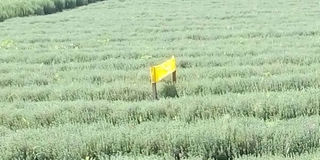Amid Covid-19 outbreak, demand for thyme grows globally

A thyme plantation. Herbs farming is slowly but steadily gaining popularity in Kenya thanks to the readily available export market. PHOTO | RACHEL KIBUI | NATION MEDIA GROUP
What you need to know:
- Ms Munyoro says thyme would be the most ideal herb for a beginner.
- She is an agronomist who specialises on herbs production and international marketing.
- The crop thrives in hot areas and needs exposure to direct sunlight for six to eight hours.
Herbs farming is slowly but steadily gaining popularity in Kenya. This is especially because of the readily available export market.
While there are various herbs which do relatively well on Kenyan soil and under the country’s climatic conditions, experts say it is advisable to begin with the easiest and grow with experience.
Ruth Munyoro, an agronomist who specialises on herbs production and international marketing, says thyme would be the most ideal herb for a beginner.
In the wake of the Covid-19 outbreak across the world, Ms Munyoro observes that the demand for herbs, especially thyme, has been on the rise.
VITAMIN C
This is especially attributed to the fact that this crop is believed to be useful in producing medication for infections on the upper respiratory system and its wealth in vitamin C.
“To begin with, this crop is not prone to diseases such as rust and pests such as aphids, thus, it is easy to manage,” says Ms Munyoro, adding that this means even farmers with no agricultural background can grow it with ease.
Besides, she adds, the crop is easy to grow. A farmer needs to prepare the land by installing drip irrigation, mixing soil with organic manure, and planting the seedlings.

Harvested thyme ready for export. PHOTO | RACHEL KIBUI | NATION MEDIA GROUP
READY FOR HARVEST
After six weeks, the crop is usually ready for the first harvest. Interestingly, a farmer can harvest from the same plant, every month, for five years.
All that the farmer needs to do is to occasionally use organic liquid fertilizer to replenish soil nutrients, weed for the crop and have the drip irrigation operational.
The fact that the crop needs only occasional weeding means it is not labour intensive as workers are only much involved during monthly harvests.
“It is not advisable to use overhead irrigation on thyme as it soils the plants, thus affecting the quality,” explains Ruth, adding that drip irrigation easily reaches to the plants’ roots unlike the overhead type.
HOT AREAS
The crop thrives in hot areas and needs exposure to direct sunlight for six to eight hours, according to Ms Munyoro.
Seedlings are usually and readily available from suppliers like Plantech Kenya Ltd, and both seeds and cuttings can be used for propagation.
Despite its many advantages, this agricultural venture can be faced with some challenges like price fluctuations depending on demand and supply.
Besides, too much rainfall can be destructive to the crop, considering that it is grown outside, unlike those which are grown in greenhouses.
Currently, Ms Munyoro says, thyme is fetching about Sh800 per kilogramme in the international market, with the main market being within the EU.
Recently, a new project was launched in Nairobi which will support the herbs and other value chains in the country.
FOOD SAFETY
Dubbed Market Upgrade Access Program (Markup) Kenya, the project is funded by European Union and is implemented by the United Nations Industrial Development Organisation (Unido), among other partners.
The project seeks to promote competitiveness and food safety along herbs and spices, mango, passion fruits, macadamia and groundnuts value chains.
Other value chains of interest to this four-year project include chillies, French beans and snow peas.
The project will be implemented in 15 counties across the country.
At the end, its effects are anticipated to be felt in form of more trade along the targeted value chains locally, regionally and internationally.
Additionally, food safety measures are expected to be geared up across the value chains, from production to consumption levels.





